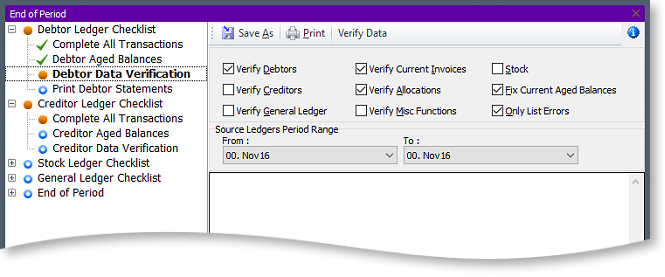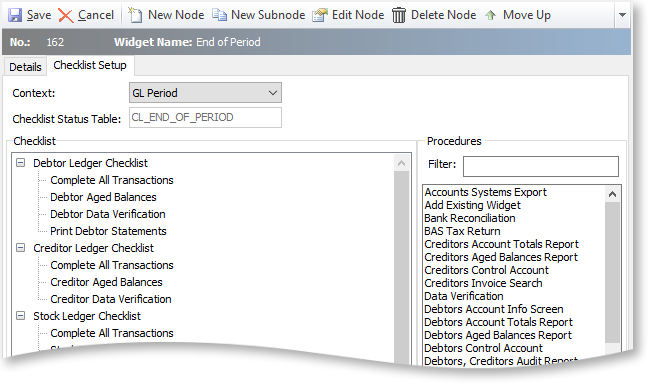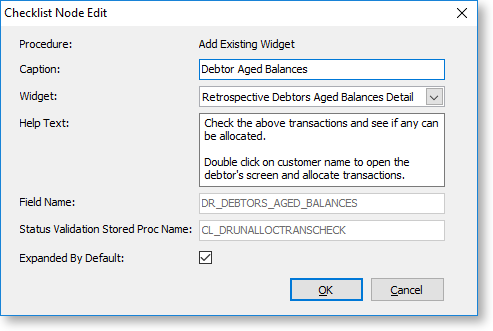Checklist Widgets
Checklist widgets are a kind of dashboard widget that display a structured list of steps, or "nodes". Each node is a separate item that can be checked off the list; nodes can be a simple note to the user, or they can link to an Exo Business menu procedure, which will open on the checklist widget display:

Buttons are available at the bottom of the checklist tree. Selecting a node on the tree and clicking these buttons changes the node’s icon to indicate its status:
 - Not Started
- Not Started - In Progress
- In Progress - Complete
- Complete - Requires Review
- Requires Review
Note: There is no button for the Requires Review status; however, it can be set by a stored procedure attached to the node.
Node statuses can also be changed by right-clicking on a node. When right-clicking on a parent node, options to set the statuses of all child nodes are available.
When "Checklist" is selected for a widget's Widget Type, a Checklist Setup tab becomes available:

To set up a checklist widget, add nodes using one of the following methods:
- To add a blank node, click the New Node button.
- To add a node that links to an Exo Business menu procedure, drag the procedure from the Procedures list onto the checklist.
In either case, the Checklist Node Edit window appears. Enter details for the node and click OK.

|
Field |
Description |
|
Procedure |
If the node links to an Exo Business menu procedure, the procedure's name is displayed here. |
|
Caption |
Enter a name for the node. This name will appear on the checklist widget when it appears on a dashboard. |
|
Parameters |
For procedures that require extra parameters, e.g. Run Clarity Report or Add Existing Widget, specify the parameters here. |
|
Widget |
When using the Add Existing Widget procedure, select the widget to add from the available widgets in this dropdown. |
|
Help Text |
Enter a short description
for the node here, explaining what its purpose is, or giving instructions
on how to use it. This text will appear at the bottom of the checklist
display when the Note: Any text that starts with www. or http:// will be displayed as a clickable hyperlink. |
|
Field Name |
The statuses of all nodes are stored in the Exo Business database, in the table specified by the Checklist Status Table property on the Checklist Setup tab. The status for this node will be stored in the field you specify here. Once set, the field name cannot be changed. Note: Field names must be unique - if you enter a field name that is the same as another node's field name, it will be prefixed with a number to make it unique, e.g. FIELD_1. If this node is deleted, the field will be removed from the database. |
|
The node's status is usually controlled by the buttons at the bottom of the checklist widget; however, it is possible to use a custom stored procedure to set the node's status. This property specifies a stored procedure that will be run when the checklist is loaded or refreshed, when the node is clicked on, or when its status is manually changed to "Complete". This procedure must take in the parameters @CONTEXTID and @NODESTATUS, and return a new @NODESTATUS value, which must be one of:
If the stored procedure name you enter here does not already exist, a default procedure with the correct inputs and outputs will be created when the table is saved (checklist procedures are automatically prefixed with "CL_"). |
|
|
Expanded By Default |
If this box is ticked, then all subnodes under this node will be displayed by default; if not, the node will be collapsed by default, so that its subnodes will be hidden until the + icon next to the node is clicked. |
Subnodes can be added under any node (including other subnodes). Select the parent node or subnode, and then click New Subnode or drag a procedure from the Procedures list onto the parent node.
Editing Nodes
Once added, nodes and subnodes can be edited by double-clicking on them or by selecting them and clicking the Edit Node button. It is also possible to re-order nodes and subnodes by dragging them drag them into a new position, or by using the Move Up and Move Down buttons.
Select a node and click Delete Node or press delete to remove that node and any sub-nodes underneath it.
Storing Checklist Node Statuses
The Checklist Status Table property on the Checklist Setup tab specifies the name of the table in the Exo Business database that will store the individual statuses of each node in the checklist. The table name you enter here must be unique; it will be created when the table is saved (checklist tables are automatically prefixed with "CL_"). Once set, the table name cannot be changed. The table contains a field for each node in the checklist - field names for each are specified by the Field Name property on the Checklist Node Edit window.
Note: If a checklist widget is deleted, a message appears asking the user if they also want to delete the associated table as well as any associated stored procedures.
Context-Specific Checklists
Checklists appearing in the Exo Accountant's Assistant can be made context-specific to a particular period. A context-specific checklist saves the status of all nodes separately for each period; when a period is selected from the Financial Period dropdown on the Exo Accountant's Assistant, the checklist updates to show the node statuses for that period.
Select an option from the Context dropdown at the top of the Checklist Setup tab:
- None
- GL Period
- Debtor Period
- Creditor Period
- Stock Period
If "None" is selected, the checklist widget will not be context-specific; otherwise it will be specific to the period for the selected ledger. When a checklist is context-specific, the table that stores checklist node statuses contains a separate line for each period.

 button is clicked.
button is clicked.